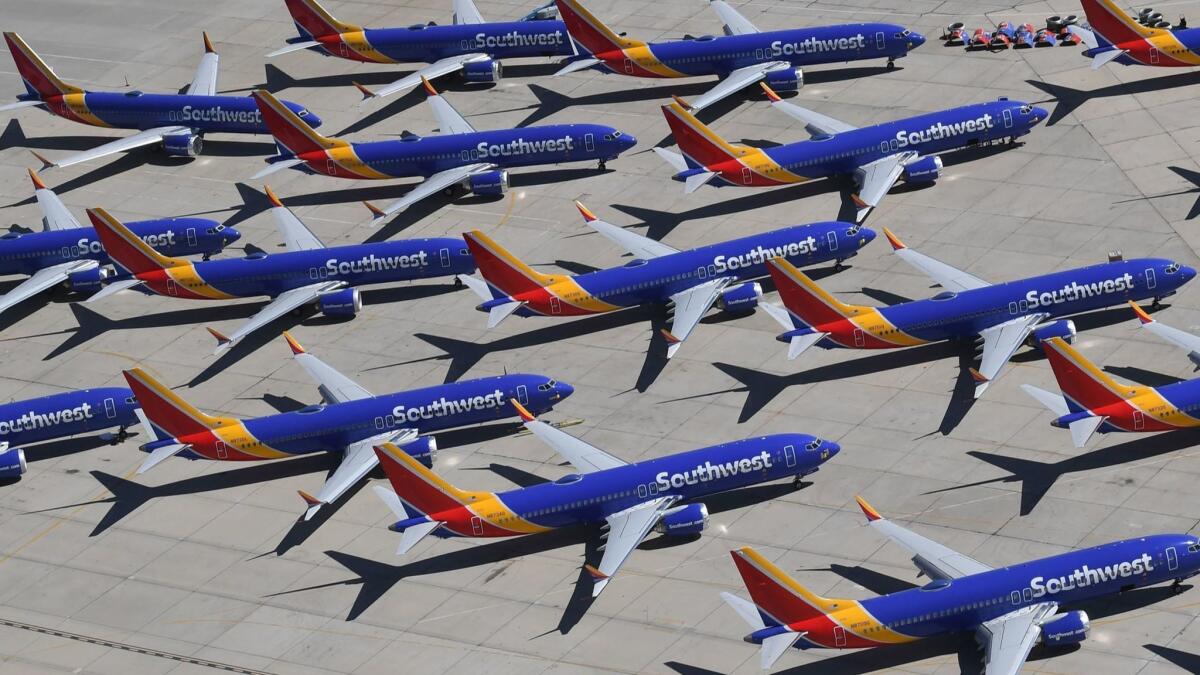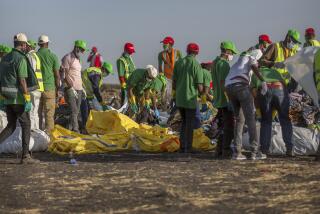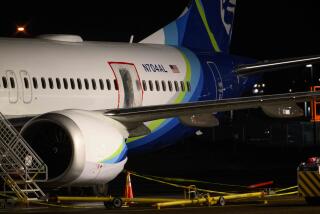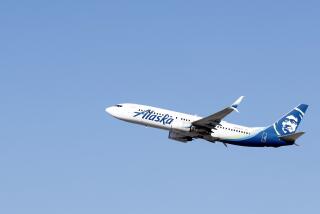Boeing pays $2,000 a month to park each 737 Max while it waits for a fix

While regulators contemplate whether Boeing Co.âs 737 Max can safely return to the skies, workers in a California airplane-storage yard keep a careful vigil against earthier concerns.
Crews have sealed 34 Southwest Airlines Co. jets against the Mojave Desertâs sun, wind and sand, as well as insects and birds that can creep into wheel wells and engine air inlets. Southwest declined to discuss the expense, but one industry veteran said such sojourns run about $2,000 a month for each plane â a small but critical cost amid Boeingâs many looming financial penalties.
The attention lavished now on the planes will help determine how fast the Max get back in the air once a worldwide grounding is lifted. Designed to ferry throngs of travelers, the young jetsâ only daily visitors these days are technicians who draw fuel samples to scout for bacterial contamination. Once a week, Southwest mechanics spool up the big turbofans, boot up flight computers, and extend and retract flight-control surfaces such as wing flaps.
âPlanes are meant to be flying and being used,ââ said Tim Zemanovic, who used to own an Arizona storage park and estimated monthly storage costs, which include labor and materials. âYouâve got to keep them that way even when theyâre in storage.ââ
The constant care extends to almost 500 grounded Max planes around the world, a total that includes about 100 factory-fresh jets that canât be delivered to customers because of the flying ban, which began in March after the second deadly crash in five months. Managing aircraft upkeep on such a scale is unprecedented, as Boeing grapples with a crisis that has already lopped $41.5 billion off its market value.
Full coverage: Boeing 737 Max planes grounded in U.S. and around the world Âť
The maintenance costs are just the start of Boeingâs financial exposure. The Chicago-based planemaker also faces an estimated $1.4 billion bill for airlinesâ canceled flights and lost operating profit if the Max fleet is still grounded by the end of September, said Bloomberg Intelligence analyst George Ferguson.
Boeingâs inventory could balloon by nearly $12 billion by the end of September if regulators donât act, and 737 production continues at the current pace, Ferguson said. âThey canât keep building and parking planes indefinitely,â he said. âWe donât think it will get to that, but itâs going to take a lot of cash to park those in the desert.â
As Boeing finalizes paperwork to certify a redesign of flight-control software linked to the two disasters, executives are laying detailed plans for the Maxâs eventual return to commercial flight. The team huddles daily and includes officials from the 737 program, corporate headquarters and the commercial and global-services divisions.
The challenge of safely pulling hundreds of planes out of storage was among the topics discussed at a summit of global regulators convened by the Federal Aviation Administration in Texas, Daniel Elwell, the agencyâs acting chief, told reporters after the meeting Thursday.
The Max grounding has long since passed the 60-day mark when aircraft are typically placed in long-term storage. Bringing them back to life will now involve a rigorous review that can last weeks as compared to days for planes that are parked for less than two months.
As the global fleet starts to come back online, Boeing plans to set up a round-the-clock operations center to support customers. Teams of mechanics, technicians and field-service representatives will fan out to assist airlines as their jets make the âtransition from storage and preservation activities to operational flight,â said Doug Alder, a Boeing spokesman.
Southwest, the largest Max operator, is already planning for the planeâs return even though itâs not clear if that is weeks or months away. âIt will be a staggered-type return to service,â said Gary Bjarke, director of contract services for the Dallas-based carrier.
Until then, Bjarke leads the team overseeing the upkeep of Southwestâs Max fleet parked on a desert plain in Victorville, Calif., east of Los Angeles. Southwest ferried all its Max planes to the storage yard in the days after U.S. regulators halted commercial flights.
Crews spent about 80 man-hours preparing each jet for storage, and Bjarke estimates it will take about 120 hours of work to get each single-aisle plane back into flying condition. In all, he said, the maintenance checks could take about 30 days before the last of the airlineâs parked 737s rejoin daily operations.
For German tour operator TUI AG, the logistics of managing its parked jets are more complicated. The company stored 13 Max at bases in Brussels, Amsterdam and Manchester, U.K., where its mechanics can tend to them, said spokesman Aage Duenhaupt. Another plane was stranded in Sofia, Bulgaria, with another in Spainâs Canary Islands, where third-party contractors are tending to them by following Boeingâs storage protocol.
The tempo of care is largely set by detailed checklists provided by Boeing. Instructions for âprolonged parkingâ run more than 100 pages in a manual for a previous generation of 737s. There are separate procedures to prepare planes depending on whether they will be parked a week, a month, two months or a year. Basic service tasks are spelled out in similar increments.
Even a simple requirement to wash an airplane is complicated by its sheer size. If a maintenance provider doesnât have a concrete pad wash area with a drain for waste water, thereâs another option: wipe the plane down by hand.
âBasically, use cleaning wipes,â said Zemanovic, the former owner of the Arizona storage park.
The manual occasionally spells out risks in colorful detail, including the bacteria or fungi that can turn jet kerosene into the consistency of âmayonnaise,â clogging the fuel system if water hasnât been thoroughly drained. There are separate lists that, step by step, make the plane serviceable once its desert stay comes to an end.
âThey just donât park them and walk away and come back six months later,â said Zemanovic, who now serves as president of Fillmore Aviation, a Minneapolis-based company that specializes in end-of-life aircraft care. âSomeoneâs looking at them every day.â
More to Read
Inside the business of entertainment
The Wide Shot brings you news, analysis and insights on everything from streaming wars to production â and what it all means for the future.
You may occasionally receive promotional content from the Los Angeles Times.










